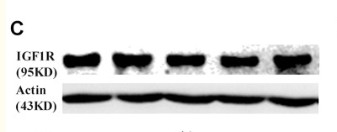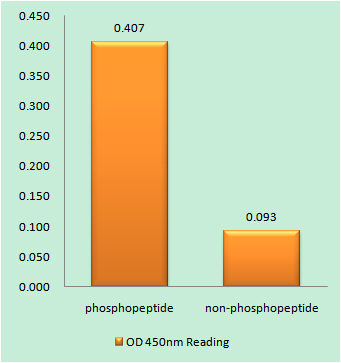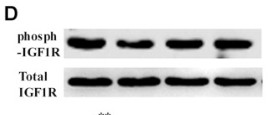
Catalog: KA1104C
Size
Price
Status
Qty.
96well
$470.00
In stock
0
Add to cart


Collected


Collect
Main Information
Reactivity
Human, Mouse, Rat
Applications
ELISA
Conjugate/Modification
Phospho
Detailed Information
Storage
2-8°C/6 months,Ship by ice bag
Modification
Phospho
Detection Method
Colorimetric
Related Products
Antigen&Target Information
Gene Name:
IGF1R
show all
Background:
catalytic activity:ATP + a [protein]-L-tyrosine = ADP + a [protein]-L-tyrosine phosphate.,disease:Defects in IGF1R may be a cause in some cases of resistance to insulin-like growth factor 1 (IGF1 resistance) [MIM:270450]. IGF1 resistance is a gowth deficiency disorder characterized by intrauterine growth retardation and poor postnatal growth accompanied with increased plasma IGF1.,enzyme regulation:Autophosphorylation activates the kinase activity.,function:This receptor binds insulin-like growth factor 1 (IGF1) with a high affinity and IGF2 with a lower affinity. It has a tyrosine-protein kinase activity, which is necessary for the activation of the IGF1-stimulated downstream signaling cascade. When present in a hybrid receptor with INSR, binds IGF1. PubMed:12138094 shows that hybrid receptors composed of IGF1R and INSR isoform Long are activated with a high affinity by IGF1, with low affinity by IGF2 and not significantly activated by insulin, and that hybrid receptors composed of IGF1R and INSR isoform Short are activated by IGF1, IGF2 and insulin. In contrast, PubMed:16831875 shows that hybrid receptors composed of IGF1R and INSR isoform Long and hybrid receptors composed of IGF1R and INSR isoform Short have similar binding characteristics, both bind IGF1 and have a low affinity for insulin.,online information:IGF-1 receptor entry,PTM:Phosphorylation of Tyr-980 is required for IRS1- and SHC1-binding.,PTM:The cytoplasmic domain of the beta subunit is autophosphorylated on tyrosine residues in response to insulin-like growth factor I (IGF I).,similarity:Belongs to the protein kinase superfamily. Tyr protein kinase family. Insulin receptor subfamily.,similarity:Contains 1 protein kinase domain.,similarity:Contains 3 fibronectin type-III domains.,subunit:Tetramer of 2 alpha and 2 beta chains linked by disulfide bonds. The alpha chains contribute to the formation of the ligand-binding domain, while the beta chain carries the kinase domain. Interacts with PIK3R1 and with the PTB/PID domains of IRS1 and SHC1 in vitro when autophosphorylated on tyrosine residues. Forms a hybrid receptor with INSR, the hybrid is a tetramer consisting of 1 alpha chain and 1 beta chain of INSR and 1 alpha chain and 1 beta chain of IGF1R.,tissue specificity:Found as a hybrid receptor with INSR in muscle, heart, kidney, adipose tissue, skeletal muscle, hepatoma, fibrobasts, spleen and placenta (at protein level). Expressed in a variety of tissues.,
show all
Function:
cell morphogenesis, cell morphogenesis involved in differentiation, reproductive developmental process, regulation of DNA replication, protein complex assembly, protein amino acid phosphorylation, phosphorus metabolic process,phosphate metabolic process, anti-apoptosis, immune response, establishment or maintenance of cell polarity, cell surface receptor linked signal transduction, enzyme linked receptor protein signaling pathway, transmembrane receptor protein tyrosine kinase signaling pathway, intracellular signaling cascade, protein kinase cascade,axonogenesis, sex determination, positive regulation of cell proliferation, insulin receptor signaling pathway, response to endogenous stimulus, response to hormone stimulus, positive regulation of biosynthetic process, response to organic substance, positive regulation of macromolecule biosynthetic process, positive regulation of macromolecule metabolic process, regulation of cell death, phosphoinositide 3-kinase cascade, phosphorylation, second-messenger-mediated signaling, establishment of cell polarity, cell projection organization, neuron differentiation, male sex determination, regulation of cell migration, positive regulation of cell migration, mammary gland development, neuron projection development, positive regulation of cellular biosynthetic process, response to insulin stimulus, cellular response to insulin stimulus, cellular response to hormone stimulus, cellular component morphogenesis, cell part morphogenesis, regulation of locomotion, positive regulation of locomotion, regulation of cell proliferation, regulation of apoptosis, negative regulation of apoptosis, regulation of programmed cell death, negative regulation of programmed cell death, response to peptide hormone stimulus, macromolecular complex subunit organization,positive regulation of DNA replication, positive regulation of nucleobase, nucleoside, nucleotide and nucleic acid metabolic process, protein amino acid autophosphorylation, insulin-like growth factor receptor signaling pathway,phosphoinositide-mediated signaling, neuron development, cell morphogenesis involved in neuron differentiation,gland development, neuron projection morphogenesis, cell projection morphogenesis, regulation of DNA metabolic process, positive regulation of DNA metabolic process, positive regulation of nitrogen compound metabolic process,protein oligomerization, protein tetramerization, regulation of cell motion, positive regulation of cell motion, protein heterooligomerization, negative regulation of cell death, macromolecular complex assembly, protein complex biogenesis,
show all
Cellular Localization:
Cell membrane ; Single-pass type I membrane protein .
show all
Signaling Pathway
Cellular Processes >> Transport and catabolism >> Autophagy - animal
Cellular Processes >> Cellular community - eukaryotes >> Focal adhesion
Cellular Processes >> Cellular community - eukaryotes >> Adherens junction
Cellular Processes >> Cellular community - eukaryotes >> Signaling pathways regulating pluripotency of stem cells
Organismal Systems >> Endocrine system >> Insulin signaling pathway
Organismal Systems >> Aging >> Longevity regulating pathway
Organismal Systems >> Aging >> Longevity regulating pathway - multiple species
Human Diseases >> Cancer: overview >> Pathways in cancer
Human Diseases >> Cancer: overview >> Transcriptional misregulation in cancer
Human Diseases >> Cancer: specific types >> Hepatocellular carcinoma
Human Diseases >> Cancer: specific types >> Glioma
Human Diseases >> Cancer: specific types >> Melanoma
Human Diseases >> Cancer: specific types >> Prostate cancer
Human Diseases >> Cancer: specific types >> Breast cancer
Human Diseases >> Neurodegenerative disease >> Alzheimer disease
Environmental Information Processing >> Signal transduction >> MAPK signaling pathway
Environmental Information Processing >> Signal transduction >> Ras signaling pathway
Environmental Information Processing >> Signal transduction >> Rap1 signaling pathway
Environmental Information Processing >> Signal transduction >> HIF-1 signaling pathway
Environmental Information Processing >> Signal transduction >> FoxO signaling pathway
Environmental Information Processing >> Signal transduction >> Phospholipase D signaling pathway
Environmental Information Processing >> Signal transduction >> cGMP-PKG signaling pathway
Environmental Information Processing >> Signal transduction >> PI3K-Akt signaling pathway
Environmental Information Processing >> Signal transduction >> AMPK signaling pathway
Environmental Information Processing >> Signal transduction >> mTOR signaling pathway
Reference Citation({{totalcount}})
Catalog: KA1104C
Size
Price
Status
Qty.
96well
$470.00
In stock
0
Add to cart


Collected


Collect
Recently Viewed Products
Clear allPRODUCTS
CUSTOMIZED
ABOUT US
Toggle night Mode
{{pinfoXq.title || ''}}
Catalog: {{pinfoXq.catalog || ''}}
Filter:
All
{{item.name}}
{{pinfo.title}}
-{{pinfo.catalog}}
Main Information
Target
{{pinfo.target}}
Reactivity
{{pinfo.react}}
Applications
{{pinfo.applicat}}
Conjugate/Modification
{{pinfo.coupling}}/{{pinfo.modific}}
MW (kDa)
{{pinfo.mwcalc}}
Host Species
{{pinfo.hostspec}}
Isotype
{{pinfo.isotype}}
Product {{index}}/{{pcount}}
Prev
Next
{{pvTitle}}
Scroll wheel zooms the picture
{{pvDescr}}



















